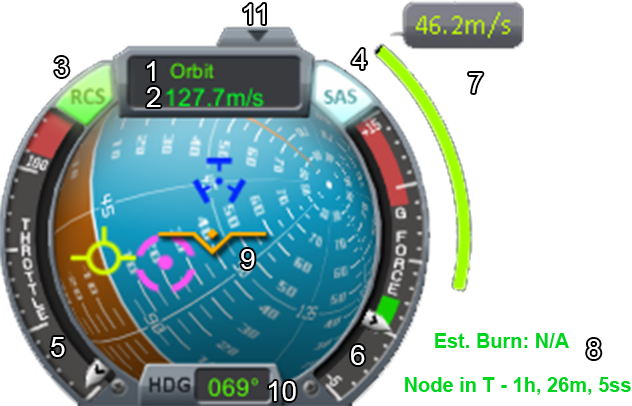Navball
Understanding the navball is critical to successful flight, both in space as in atmosphere. When the camera is not in chase mode only the navball can tell the current orientation and what the rotation commands will perform.
Point of Reference
Clicking this area will toggle the reference between Surface and Orbit, indicated by the green text. If a target is selected on the map, there is the additional option Target to cycle through. Changing the point of reference changes the location of the pro-grade and retro-grade markers.
Speed
The speed is measured relative to the point of reference.
Ball instrument
The most important part is the center ball which shows the current orientation of the craft and multiple directions which maybe important for future movements.
While blue background indicates skyward directions the brown indicates groundwards. The white line in the middle is the artificial horizon.
Markers
On the navball are three different types of markers. All markers except the maneuver marker have an opposite marker on the other side of the virtual ball.
Level indicator
| |
The level indicator shows the current orientation. As the navball is rotating beneath the level indicator, the navball is like a cockpit view without any window needed. So a rotation at the roll axis will turn the navball upside down.
Prograde and retrograde
| |
|
The prograde and retrograde marker is facing in the direction of movement. As the craft orbits in most cases around a body these markers are moving. Burning at the prograde will accelerate the craft while burning retrograde will doing the opposite.
Target
| |
|
If a target is selected the purple icons are indicating at which direction the target is. Because the target is also moving the target marker is also moving and isn't fixed.
Maneuver
| |
If a maneuver is planned on the map, the maneuver marker is pointing in the needed direction to burn. This is the only marker without the opposite which could complicate using maneuver nodes when the engines are facing backwards.
Information around
On maneuvers, you additionally get a maneuver thrust indicator, a green bar and small info text right of the navball. The bar indicates the total amount of thrust required in the maneuver direction and it will deplete as you perform your burn. Below that is indicated how long your burn will have to continue until you complete your maneuver. This is a mere estimation based on your current thrust level, so altering thrust controls will also immediately alter this value. Below that is a timer indicating the time left until you reach your maneuver node where you should start your burn.
Throttle
Throttle is at how much power all engines are running (in percent). Beware of full throttle, as engines can overheat and then can be destroyed. This throttle will always control all engines, so if the engines are not balanced there is no way to balance this by reducing the power for those engines which apply to much thrust. Also it controls the engines equally at the given percentage so smaller engines will apply lower force.
Heading
The heading is the direction in degrees that the craft is facing. As most bodies are rotating eastwards it is more fuel efficent to head at the east.
G forces
G forces are the pressures exerted due to acceleration measured in a factor of g. One g is approximately 9.81 m/s2.
Hide
Clicking the little arrow on the top of the navball (Hide) will toggles its display on-screen.
Basic controls
These are the most basic orientation controls of your craft, here is a short explanation on how their actions are represented on the navball.
Default control W moves the indicator down on the navball.
Default control S moves it up.
Default control A moves it left.
Default control D moves it right.
Default control Q rolls it counterclockwise.
Default control E rolls it clockwise.
